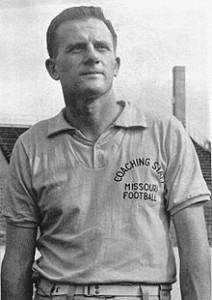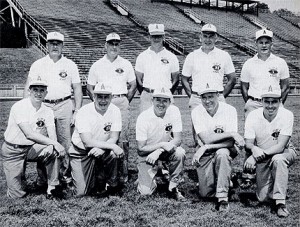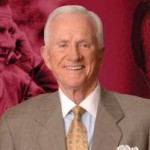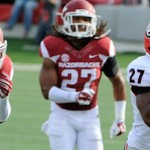Editor’s Note: This is the second in a four-part series about Frank Broyles, the former Arkansas head football coach and athletic director, whose career at Arkansas came to an end earlier this month with his retirement in Fayetteville. Part one is available here.
 As a college football player, Frank Broyles had the kind of career that, had he been an Arkansas Razorback, would make him still one of the most talked about Hogs of all time. However, when Broyles was 21 during the 1946 football season he was as far away from being a Hog as possible — Arkansas probably didn’t enter his mind at all.
As a college football player, Frank Broyles had the kind of career that, had he been an Arkansas Razorback, would make him still one of the most talked about Hogs of all time. However, when Broyles was 21 during the 1946 football season he was as far away from being a Hog as possible — Arkansas probably didn’t enter his mind at all.
He was such a football star at Georgia Tech, then in the Southeastern Conference, in 1944 that he was named the SEC’s player of the year, playing single-wing quarterback and setting all kinds of passing records. His single-game Orange Bowl passing stats lasted until Tom Brady came around in 2000 with Michigan to finally break them.
Broyles could have continued with his football career in the pros — the NFL’s Chicago Bears drafted him after the 1946 season — but he already knew that coaching was in his blood.
He had been the coach on the field for Georgia Tech’s legendary Bobby Dodd and he was ready to continue that on the sidelines. Arkansas’ sidelines, however, were still probably furthest from his mind. Arkansas football was still not something talked about beyond perhaps Southwest Conference borders until 1946, when John Barnhill took his first Razorback team to the Cotton Bowl and tied LSU 0-0 in a game that followed an ice storm that hit the Dallas area before New Year’s.
To understand Broyles as a coach, one must look at the coaches under whom he learned the game, starting with Dodd, who had excelled as a player under Gen. Bob Neyland at Tennessee and took that vast knowledge to Atlanta to turn Georgia Tech into a power through the 1950s.
Arkansas, tasting some SWC success in the 1930s, made its first serious move to be a football power in hiring John Barnhill, who had been Neyland’s aide-de-camp at Knoxville and took over as Vols head coach when Neyland went to war. When Neyland returned from WWII, Barnhill had to find an open head coaching job to continue serving in that role, and Arkansas beckoned.
This would begin the change that brought Broyles to Fayetteville and started the Hogs on their greatest run of football success.
After Broyles’ playing career ended, he was hired by former Neyland assistant Bob Woodruff as his offensive coach at Baylor. It was in 1948 that Broyles would see Fayetteville on a football sideline for the first time, and in the SWC he’d already begun to witness what was happening in Arkansas as Barnhill’s program took hold and what was possible there.
Woodruff, after turning Baylor into a winner, would take Broyles, who was already gaining a strong reputation as an offensive mind, to Florida in 1950. This was not the Florida Gator program that we know of today, but rather one that needed some solid foundation established. Woodruff would be the man who did that over the next decade. Broyles was there for year one before Dodd summoned him back to Atlanta to coach the Yellow Jackets’ offense.
During his time back at Georgia Tech, Broyles would be credited with inventing the “belly” series or running, utilizing an option between the quarterback and fullback at the point of attack that was difficult for defenses to read or defend (that “belly” series would become instrumental piece of the vaunted Wishbone offensive attack beginning in the late ’60s). Georgia Tech also would be to college football what Florida State later became in the 1990s, as it dominated the bowl season with win after win during the 1950s. One of those came against Arkansas in the 1955 Cotton Bowl, 14-6, giving Broyles another glimpse of what an excited Razorback fan base could look like. The 1954 Hogs that ended up in Dallas were Bowden Wyatt’s second and last team before he would light out for Tennessee and the Vols’ head coaching job. Wyatt ignited strong passion about the Hogs, taking the “25 Little Pigs” from a 3-7 team the year before (and a run of four straight non-winning seasons) to 7-3 and SWC champions, as well as 6-0 upset winners of SEC powerhouse Ole Miss.
 When Broyles finally got the Arkansas job, after one year at Missouri, in 1958, he quickly assembled a coaching staff that included Little Rock Central icon Wilson Matthews, who had probably hoped to one day be Arkansas’ coach after his incredible high school coaching run. Matthews would end up being Broyles’ “bad cop” to the head coach’s “nice cop” style — a perfect pairing, it turned out. (Matthews would later be Broyles’ man, when Broyles became athletic director, to build the football donation system that became the Razorback Foundation. Again, Broyles as the politician with would-be boosters, while Matthews was the tough-guy chief of staff, and eventually no one could say “no” to their requests.)
When Broyles finally got the Arkansas job, after one year at Missouri, in 1958, he quickly assembled a coaching staff that included Little Rock Central icon Wilson Matthews, who had probably hoped to one day be Arkansas’ coach after his incredible high school coaching run. Matthews would end up being Broyles’ “bad cop” to the head coach’s “nice cop” style — a perfect pairing, it turned out. (Matthews would later be Broyles’ man, when Broyles became athletic director, to build the football donation system that became the Razorback Foundation. Again, Broyles as the politician with would-be boosters, while Matthews was the tough-guy chief of staff, and eventually no one could say “no” to their requests.)
Broyles espoused all the ideals that Neyland had won with at Tennessee, that Dodd had won with at Georgia Tech and that Woodruff had succeeded with at Baylor and Florida — defense and the kicking game came first. Broyles did not outright copy the General’s famed “Seven Maxims,” but it ran through every aspect of the Hogs’ program beginning in 1958 — such as, the team that made the fewest mistakes would win. Broyles played the game with a focus on field position and capitalizing on an opponents’ errors. His offensive ingenuity also kept the Razorbacks a step ahead of most of the competition and allowed them to match all-powerful Texas at times.
Just as Neyland’s, Dodd’s and Woodruff’s staffs produced legendary coaches to follow, Broyles’ Arkansas coaching staffs became a tree that would seed a forest of future powerhouses or restore to greatness the fallen ones.
Try to imagine today any Arkansas staff producing a coach who immediately would become the head coach at Oklahoma, Tennessee, Vanderbilt, Iowa State, SMU, Clemson, Virginia Tech or North Carolina State. That’s the type of coaching talent Broyles’ staffs contained. Broyles could point to one of his previous hires, such as Doug Dickey in the early 1960s, and could interest a coach on the way up that spending some time at Fayetteville, even at low wages, was the ticket to a nice head coaching gig.
Clemson, Virginia Tech or North Carolina State. That’s the type of coaching talent Broyles’ staffs contained. Broyles could point to one of his previous hires, such as Doug Dickey in the early 1960s, and could interest a coach on the way up that spending some time at Fayetteville, even at low wages, was the ticket to a nice head coaching gig.
One of those hires was Hayden Fry, who had played quarterback for Woodruff and Broyles at Baylor and who took over when Dickey went from the UA to Tennessee. Fry, later as the coach who would turn Iowa around after successful stops at SMU and North Texas, would take a walk-on from Illinois and turn him into a solid defensive lineman and team captain, and then get him started in the coaching business: Hogs current head coach Bret Bielema.
Broyles’ coaching legacy stretched to the pros, with former assistants Jimmy Johnson, Joe Gibbs and Barry Switzer winning Super Bowls, while Raymond Berry coached a Super Bowl contender in New England. Many other assistants left after tutelage from Broyles to eventually land at college powerhouses where they either won titles or became coaching icons in their own right, such as Johnny Majors and Jackie Sherrill.
Broyles’ own 1964 defensive and punt returning star, Ken Hatfield, would answer Broyles call to bring his innovative “flexbone” offense from Air Force, where he had turned a floundering program with built-in talent deficiencies completely around, to lead the Hogs from 1984-89, winning consecutive SWC championships at the end of that run. One of Broyles’ last recruits as a head coach, Little Rock prep quarterbacking sensation Houston Nutt, would later return as Razorback head coach in December 1997 and immediately reestablish the excitement in the Razorback football brand in 1998, the same way Bowden Wyatt had done in his short tenure in Fayetteville. Nutt would be Broyles’ last football hire.
But the great coach’s legacy as the mentor to top assistants remains every year in the form of the Broyles Award, presented to the nation’s top assistant coach as determined by nominations from FBS head coaches and with the finalists and winner chosen by a select crew of former national coaching greats. The award is best defined by the trophy, showing the typical Broyles sideline pose of the 1960s with his chief assistant, Wilson Matthews, beside him and bent at the hips, hands on the knees, intently watching the action. The trophy could easily feature Broyles at the side of Bobby Dodd or Bob Woodruff, too, as an able assistant coach with a great mind making a huge difference on the sideline; because before he was one of the winningest coaches in college football history and a Hall of Famer, Broyles was clearly one of the best assistants.
Perhaps we will know Arkansas football has returned to its zenith of the Broyles’ days when Hog assistant coaches again are being pursued by college football’s biggest names to be not just part of their staffs, but hired as their head coaches.
NEXT WEEK: Broyles as athletic director














